BioChemistry > Judgements > Exam #3 PN 2 Ch. 64, 46-48, 41-44 (complete latest solution guide) Latest Spring 2020/2021 (All)
Exam #3 PN 2 Ch. 64, 46-48, 41-44 (complete latest solution guide) Latest Spring 2020/2021
Document Content and Description Below
Exam #3 PN 2 Ch. 64, 46-48, 41-44 Know what the left temporal lobe of brain affects as far as the senses 1. 1. A nurse prepares to teach a client who has experienced damage to the left temporal lobe o... f the brain. Which action should the nurse take when providing education about newly prescribed medications to this client? a. Help the client identify each medication by its color. b. Provide written materials with large print size. c. Sit on the clients right side and speak into the right ear. d. Allow the client to use a white board to ask questions. ANS: C The temporal lobe contains the auditory center for sound interpretation. The clients hearing will be impaired in the left ear. The nurse should sit on the clients right side and speak into the right ear. The other interventions do not address the clients left temporal lobe damage. Know what hypoactive deep tendon reflexes affect 2. A nurse plans care for a client who has a hypoactive response to a test of deep tendon reflexes. Which intervention should the nurse include in this clients plan of care? a. Check bath water temperature with a thermometer. b. Provide the client with assistance when ambulating. c. Place elastic support hose on the clients legs. d. Assess the clients feet for wounds each shift. ANS: B Hypoactive deep tendon reflexes and loss of vibration sense can impair balance and coordination, predisposing the client to falls. The nurse should plan to provide the client with ambulation assistance to prevent injury. The other interventions do not address the clients problem. Know what things can interfere with MRI scans 10. A nurse obtains a focused health history for a client who is scheduled for magnetic resonance imaging (MRI). Which condition should alert the nurse to contact the provider and cancel the procedure? a. Creatine phosphokinase (CPK) of 100 IU/L b. Atrioventricular graft c. Blood urea nitrogen (BUN) of 50 mg/dL d. Internal insulin pump ANS: D Metal devices such as internal pumps, pacemakers, and prostheses interfere with the accuracy of the image and can become displaced by the magnetic force generated by an MRI procedure. An atrioventricular graft does not contain any metal. CPK and BUN levels have no impact on an MRI procedure. 14. After teaching a client who is scheduled for magnetic resonance imaging (MRI), the nurse assesses the clients understanding. Which client statement indicates a correct understanding of the teaching? a. I must increase my fluids because of the dye used for the MRI. b. My urine will be radioactive so I should not share a bathroom. c. I can return to my usual activities immediately after the MRI. d. My gag reflex will be tested before I can eat or drink anything. ANS: C No postprocedure restrictions are imposed after MRI. The client can return to normal activities after the test is complete. There are no dyes or radioactive materials used for the MRI; therefore, increased fluids are not needed and the clients urine would not be radioactive. The procedure does not impact the clients gag reflex. Know what a single-photon emission computed tomography (SPECT) scan is and if there is any care required afterwards 20. A nurse cares for a client who is recovering from a single-photon emission computed tomography (SPECT) with a radiopharmaceutical agent. Which statement should the nurse include when discussing the plan of care with this client? a. You may return to your previous activity level immediately. b. You are radioactive and must use a private bathroom. c. Frequent assessments of the injection site will be completed. d. We will be monitoring your renal functions closely. ANS: A The client may return to his or her previous activity level immediately. Radioisotopes will be eliminated in the urine after SPECT, but no monitoring or special precautions are required. The injection site will not need to be assessed after the procedure is complete. Know what imitrex is and any side effects associated with it 3. A nurse obtains a health history on a client prior to administering prescribed sumatriptan succinate (Imitrex) for migraine headaches. Which condition should alert the nurse to hold the medication and contact the health care provider? a. Bronchial asthma b. Prinzmetals angina c. Diabetes mellitus d. Chronic kidney disease ANS: B Sumatriptan succinate effectively reduces pain and other associated symptoms of migraine headache by binding to serotonin receptors and triggering cranial vasoconstriction. Vasoconstrictive effects are not confined to the cranium and can cause coronary vasospasm in clients with Prinzmetals angina. The other conditions would not affect the clients treatment. What is bacterial meningitis and how is it contracted? 9. A nurse obtains a focused health history for a client who is suspected of having bacterial meningitis. Which question should the nurse ask? a. Do you live in a crowded residence? b. When was your last tetanus vaccination? c. Have you had any viral infections recently? d. Have you traveled out of the country in the last month? ANS: A Meningococcal meningitis tends to occur in multiple outbreaks. It is most likely to occur in areas of high-density population, such as college dormitories, prisons, and military barracks. A tetanus vaccination would not place the client at increased risk for meningitis or protect the client from meningitis. A viral infection would not lead to bacterial meningitis but could lead to viral meningitis. Simply knowing if the client traveled out of the country does not provide enough information. The nurse should ask about travel to specific countries in which the disease is common, for example, sub-Saharan Africa. What are clinical manifestations of Parkinson’s? 10. After teaching the wife of a client who has Parkinson disease, the nurse assesses the wifes understanding. Which statement by the clients wife indicates she correctly understands changes associated with this disease? a. His masklike face makes it difficult to communicate, so I will use a white board. b. He should not socialize outside of the house due to uncontrollable drooling. c. This disease is associated with anxiety causing increased perspiration. d. He may have trouble chewing, so I will offer bite-sized portions. ANS: D Because chewing and swallowing can be problematic, small frequent meals and a supplement are better for meeting the clients nutritional needs. A masklike face and drooling are common in clients with Parkinson disease. The client should be encouraged to continue to socialize and communicate as normally as possible. The wife should understand that the clients masklike face can be misinterpreted and additional time may be needed for the client to communicate with her or others. Excessive perspiration is also common in clients with Parkinson disease and is associated with the autonomic nervous systems response. 11. A nurse plans care for a client with Parkinson disease. Which intervention should the nurse include in this clients plan of care? a. Ambulate the client in the hallway twice a day. b. Ensure a fluid intake of at least 3 liters per day. c. Teach the client pursed-lip breathing techniques. d. Keep the head of the bed at 30 degrees or greater. ANS: D Elevation of the head of the bed will help prevent aspiration. The other options will not prevent aspiration, which is the greatest respiratory complication of Parkinson disease, nor do these interventions address any of the complications of Parkinson disease. Ambulation in the hallway is usually implemented to prevent venous thrombosis. Increased fluid intake flushes out toxins from the clients blood. Pursed-lip breathing increases exhalation of carbon dioxide. Know patient/family teaching for Alzheimer’s and what the medications do 12. A nurse is teaching the daughter of a client who has Alzheimers disease. The daughter asks, Will the medication my mother is taking improve her dementia? How should the nurse respond? a. It will allow your mother to live independently for several more years. b. It is used to halt the advancement of Alzheimers disease but will not cure it. c. It will not improve her dementia but can help control emotional responses. d. It is used to improve short-term memory but will not improve problem solving. ANS: C Drug therapy is not effective for treating dementia or halting the advancement of Alzheimers disease. However, certain drugs may help suppress emotional disturbances and psychiatric manifestations. Medication therapy may not allow the client to safely live independently. 13. A nurse assesses a client with Alzheimers disease who is recently admitted to the hospital. Which psychosocial assessment should the nurse complete? a. Assess religious and spiritual needs while in the hospital. b. Identify the clients ability to perform self-care activities. c. Evaluate the clients reaction to a change of environment. d. Ask the client about relationships with family members. ANS: C As Alzheimers disease progresses, the client experiences changes in emotional and behavioral affect. The nurse should be alert to the clients reaction to a change in environment, such as being hospitalized, because the client may exhibit an exaggerated response, such as aggression, to the event. The other assessments should be completed but are not as important as assessing the clients reaction to environmental change. 14. A nurse witnesses a client with late-stage Alzheimers disease eat breakfast. Afterward the client states, I am hungry and want breakfast. How should the nurse respond? a. I see you are still hungry. I will get you some toast. b. You ate your breakfast 30 minutes ago. c. It appears you are confused this morning. d. Your family will be here soon. Lets get you dressed. ANS: A Use of validation therapy with clients who have Alzheimers disease involves acknowledgment of the clients feelings and concerns. This technique has proved more effective in later stages of the disease, when using reality orientation only increases agitation. Telling the client that he or she already ate breakfast may agitate the client. The other statements do not validate the clients concerns. 16. A nurse cares for a client with advanced Alzheimers disease. The clients caregiver states, She is always wandering off. What can I do to manage this restless behavior? How should the nurse respond? a. This is a sign of fatigue. The client would benefit from a daily nap. b. Engage the client in scheduled activities throughout the day. c. It sounds like this is difficult for you. I will consult the social worker. d. The provider can prescribe a mild sedative for restlessness. ANS: B Several strategies may be used to cope with restlessness and wandering. One strategy is to engage the client in structured activities. Another is to take the client for frequent walks. Daily naps and a mild sedative will not be as effective in the management of restless behavior. Consulting the social worker does not address the caregivers concern. 17. A nurse prepares to discharge a client with Alzheimers disease. Which statement should the nurse include in the discharge teaching for this clients caregiver? a. Allow the client to rest most of the day. b. Place a padded throw rug at the bedside. c. Install deadbolt locks on all outside doors. d. Provide a high-calorie and high-protein diet. ANS: C How do you treat lower back pain? 1. A nurse promotes the prevention of lower back pain by teaching clients at a community center. Which instruction should the nurse include in this education? a. Participate in an exercise program to strengthen muscles. b. Purchase a mattress that allows you to adjust the firmness. c. Wear flat instead of high-heeled shoes to work each day. d. Keep your weight within 20% of your ideal body weight. ANS: A Exercise can strengthen back muscles, reducing the incidence of low back pain. The other options will not prevent low back pain. 2. A nurse plans care for a client with lower back pain from a work-related injury. Which intervention should the nurse include in this clients plan of care? a. Encourage the client to stretch the back by reaching toward the toes. b. Massage the affected area with ice twice a day. c. Apply a heating pad for 20 minutes at least four times daily. d. Advise the client to avoid warm baths or showers. ANS: C Heat increases blood flow to the affected area and promotes healing of injured nerves. Stretching and ice will not promote healing, and there is no need to avoid warm baths or showers. 4. A nurse assesses clients at a community center. Which client is at greatest risk for lower back pain? a. A 24-year-old female who is 25 weeks pregnant b. A 36-year-old male who uses ergonomic techniques c. A 45-year-old male with osteoarthritis d. A 53-year-old female who uses a walker ANS: C Osteoarthritis causes changes to support structures, increasing the clients risk for low back pain. The other clients are not at high risk. What happens with spinal cord injuries at level T5? Clinical manifestations? 7. A nurse assesses a client with a spinal cord injury at level T5. The clients blood pressure is 184/95 mm Hg, and the client presents with a flushed face and blurred vision. Which action should the nurse take first? a. Initiate oxygen via a nasal cannula. b. Place the client in a supine position. c. Palpate the bladder for distention. d. Administer a prescribed beta blocker. ANS: C The client is manifesting symptoms of autonomic dysreflexia. Common causes include bladder distention, tight clothing, increased room temperature, and fecal impaction. If persistent, the client could experience neurologic injury. Precipitating conditions should be eliminated and the physician notified. The other actions would not be appropriate. 7. A nurse assesses a client who experienced a spinal cord injury at the T5 level 12 hours ago. Which manifestations should the nurse correlate with neurogenic shock? (Select all that apply.) a. Heart rate of 34 beats/min b. Blood pressure of 185/65 mm Hg c. Urine output less than 30 mL/hr d. Decreased level of consciousness e. Increased oxygen saturation ANS: A, C, D Neurogenic shock with acute spinal cord injury manifests with decreased oxygen saturation, symptomatic bradycardia, decreased level of consciousness, decreased urine output, and hypotension. What happens in cervical spine injuries? Clinical manifestations? 8. An emergency room nurse initiates care for a client with a cervical spinal cord injury who arrives via emergency medical services. Which action should the nurse take first? a. Assess level of consciousness. b. Obtain vital signs. c. Administer oxygen therapy. d. Evaluate respiratory status. ANS: D The first priority for a client with a spinal cord injury is assessment of respiratory status and airway patency. Clients with cervical spine injuries are particularly prone to respiratory compromise and may even require intubation. The other assessments should be performed after airway and breathing are assessed What is the purpose of rehabilitation for patients with paraplegia? 11. A nurse is caring for a client with paraplegia who is scheduled to participate in a rehabilitation program. The client states, I do not understand the need for rehabilitation; the paralysis will not go away and it will not get better. How should the nurse respond? a. If you dont want to participate in the rehabilitation program, Ill let the provider know. b. Rehabilitation programs have helped many clients with your injury. You should give it a chance. c. The rehabilitation program will teach you how to maintain the functional ability you have and prevent further disability. d. When new discoveries are made regarding paraplegia, people in rehabilitation programs will benefit first. ANS: C Participation in rehabilitation programs has many purposes, including prevention of disability, maintenance of functional ability, and restoration of function. The other responses do not meet this clients needs. 6. A nurse assesses a client with paraplegia from a spinal cord injury and notes reddened areas over the clients hips and sacrum. Which actions should the nurse take? (Select all that apply.) a. Apply a barrier cream to protect the skin from excoriation. b. Perform range-of-motion (ROM) exercises for the hip joint. c. Re-position the client off of the reddened areas. d. Get the client out of bed and into a chair once a day. e. Obtain a low-air-loss mattress to minimize pressure. ANS: C, E What are the clinical manifestations of early multiple sclerosis (MS)? 13. A nurse assesses a client with early-onset multiple sclerosis (MS). Which clinical manifestation should the nurse expect to find? a. Hyperresponsive reflexes b. Excessive somnolence c. Nystagmus d. Heat intolerance ANS: C Early signs and symptoms of MS include changes in motor skills, vision, and sensation. Hyperresponsive reflexes, excessive somnolence, and heat intolerance are later manifestations of MS. Know what Gilenya medication is used for and any side effects that can be caused 15. A nurse assesses a client with multiple sclerosis after administering prescribed fingolimod (Gilenya). For which adverse effect should the nurse monitor? a. Peripheral edema b. Black tarry stools c. Bradycardia d. Nausea and vomiting ANS: C Fingolimod (Gilenya) is an antineoplastic agent that can cause bradycardia, especially within the first 6 hours after administration. Peripheral edema, black and tarry stools, and nausea and vomiting are not adverse effects of fingolimod. Know the late clinical manifestation of ALS 17. A nurse assesses a client with a neurologic disorder. Which assessment finding should the nurse identify as a late manifestation of amyotrophic lateral sclerosis (ALS)? a. Dysarthria b. Dysphagia c. Muscle weakness d. Impairment of respiratory muscles ANS: D In ALS, progressive muscle atrophy occurs until a flaccid quadriplegia develops. Eventually, the respiratory muscles are involved, which leads to respiratory compromise. Dysarthria, dysphagia, and muscle weakness are early clinical manifestations of ALS. What is Guillain-Barre? What are the clinical manifestations? How is it treated? 1. A client is admitted with Guillain-Barr syndrome (GBS). What assessment takes priority? a. Bladder control b. Cognitive perception c. Respiratory system d. Sensory functions ANS: C Clients with GBS have muscle weakness, possibly to the point of paralysis. If respiratory muscles are paralyzed, the client may need mechanical ventilation, so the respiratory system is the priority. The nurse will complete urinary, cognitive, and sensory assessments as part of a thorough evaluation. 2. The nurse learns that the pathophysiology of Guillain-Barr syndrome includes segmental demyelination. The nurse should understand that this causes what? a. Delayed afferent nerve impulses b. Paralysis of affected muscles c. Paresthesia in upper extremities d. Slowed nerve impulse transmission ANS: D Demyelination leads to slowed nerve impulse transmission. The other options are not correct. 3. A client with Guillain-Barr syndrome is admitted to the hospital. The nurse plans caregiving priority to interventions that address which priority client problem? a. Anxiety b. Low fluid volume c. Inadequate airway d. Potential for skin breakdown ANS: C Airway takes priority. Anxiety is probably present, but a physical diagnosis takes priority over a psychosocial one. The client has no reason to have low fluid volume unless he or she has been unable to drink for some time. If present, airway problems take priority over a circulation [Show More]
Last updated: 1 year ago
Preview 1 out of 20 pages

Reviews( 0 )
Recommended For You
*NURSING> Judgements > HESI V3 PN EXIT EXAM 110 QUESTIONS AND ANSWER. (All)

HESI V3 PN EXIT EXAM 110 QUESTIONS AND ANSWER.
1. An adult client experiences a gasoline tank fire when riding a motorcycle and is admitted to the emergency department (ED) with full thickness burns to all surfaces of both lower extremities. Wha...
By charlie1988 , Uploaded: Feb 22, 2022
$13
*NURSING> Judgements > (Solved) NURS 6630 Week 7 Assignment: Assessing and Treating Patients With Psychosis and Schizophrenia (All)

(Solved) NURS 6630 Week 7 Assignment: Assessing and Treating Patients With Psychosis and Schizophrenia
NURS 6630 Week 7 Assignment: Assessing and Treating Patients with Psychosis and Schizophrenia Walden University NURS -6630, Psychopharmacologic Approaches to Treatment of Psychopathology (Solution) NU...
By A+ Solutions , Uploaded: Jul 27, 2022
$10
*NURSING> Judgements > VSIM Christopher Parrish Diagnosis: Cystic Fibrosis feedback log - Scored 100% (latest 2020/2021) (All)
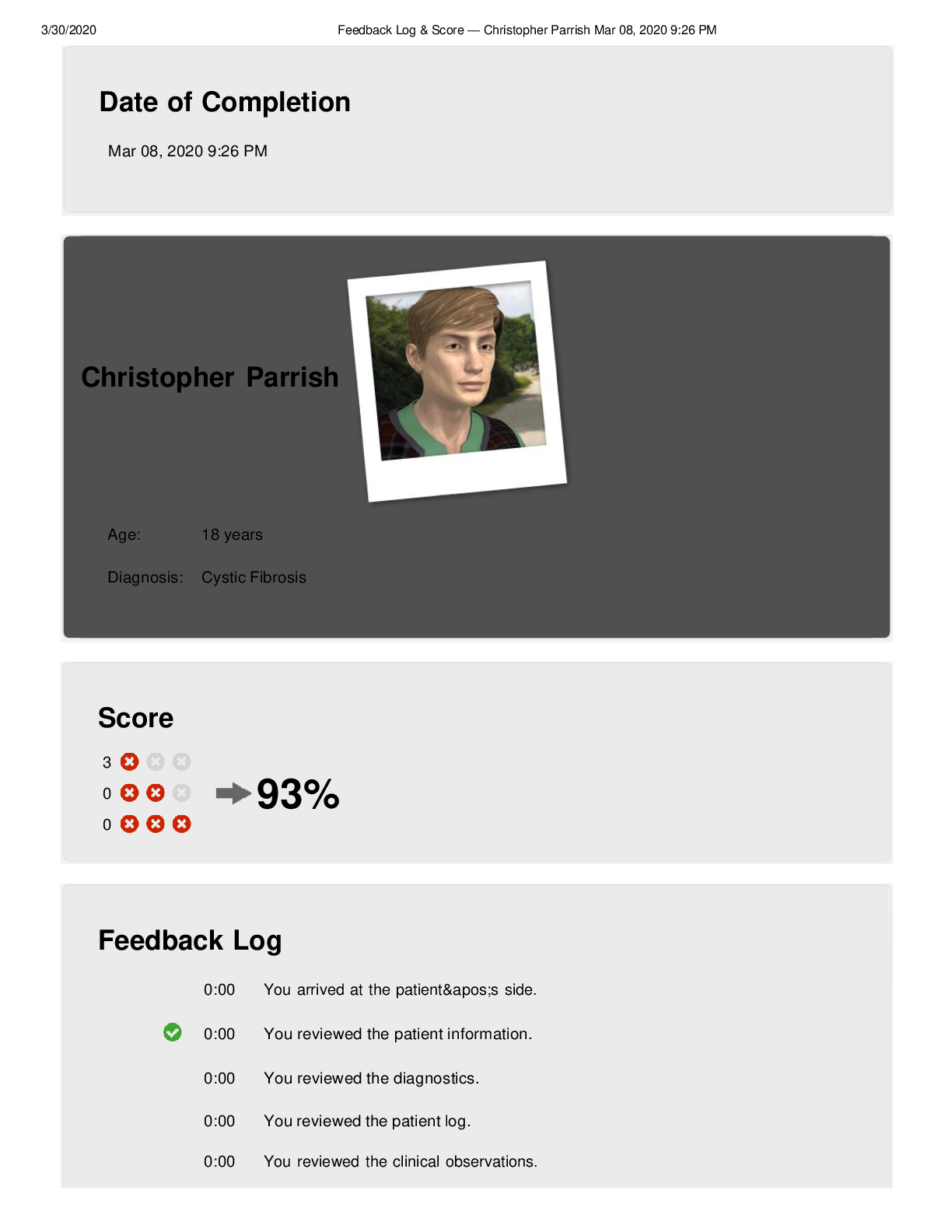
VSIM Christopher Parrish Diagnosis: Cystic Fibrosis feedback log - Scored 100% (latest 2020/2021)
Date of Completion Mar 08, 2020 9:26 PM Score 3 0 0 93% Feedback Log 0:00 You arrived at the patient's side. 0:00 You reviewed the patient information. 0:00 You reviewed the diagnostics...
By A grade master , Uploaded: Dec 28, 2021
$6
Research Methods> Judgements > Southern New Hampshire University MAT 125 Final Project-REVIEWED AND VERIFIED BY EXPERTS 2021 (All)

Southern New Hampshire University MAT 125 Final Project-REVIEWED AND VERIFIED BY EXPERTS 2021
Final Project [Larisa Borshman] Congratulations on graduating with your bachelor’s degree from Southern New Hampshire University! A new array of opportunities is open to you, but which will you cho...
By d.occ , Uploaded: Jun 17, 2021
$15
Law> Judgements > JUS 620 Exploration of Law and Public Policy Week 1 to 8 2020 (All)

JUS 620 Exploration of Law and Public Policy Week 1 to 8 2020
JUS 620 Exploration of Law and Public Policy JUS 620 Week 1 Assignment, Crime in America Essay JUS 620 Topic 1 DQ 1 and 2 JUS 620 Week 2 Assignment, Is Justice Truly Blind JUS 62...
By QuizBank , Uploaded: Apr 06, 2021
$80
*NURSING> Judgements > RN VATI Adult Medical Surgical 2019;Mohave Community College - MED SURG 450 RN VATI Adult Medical Surgical 2019 (All)
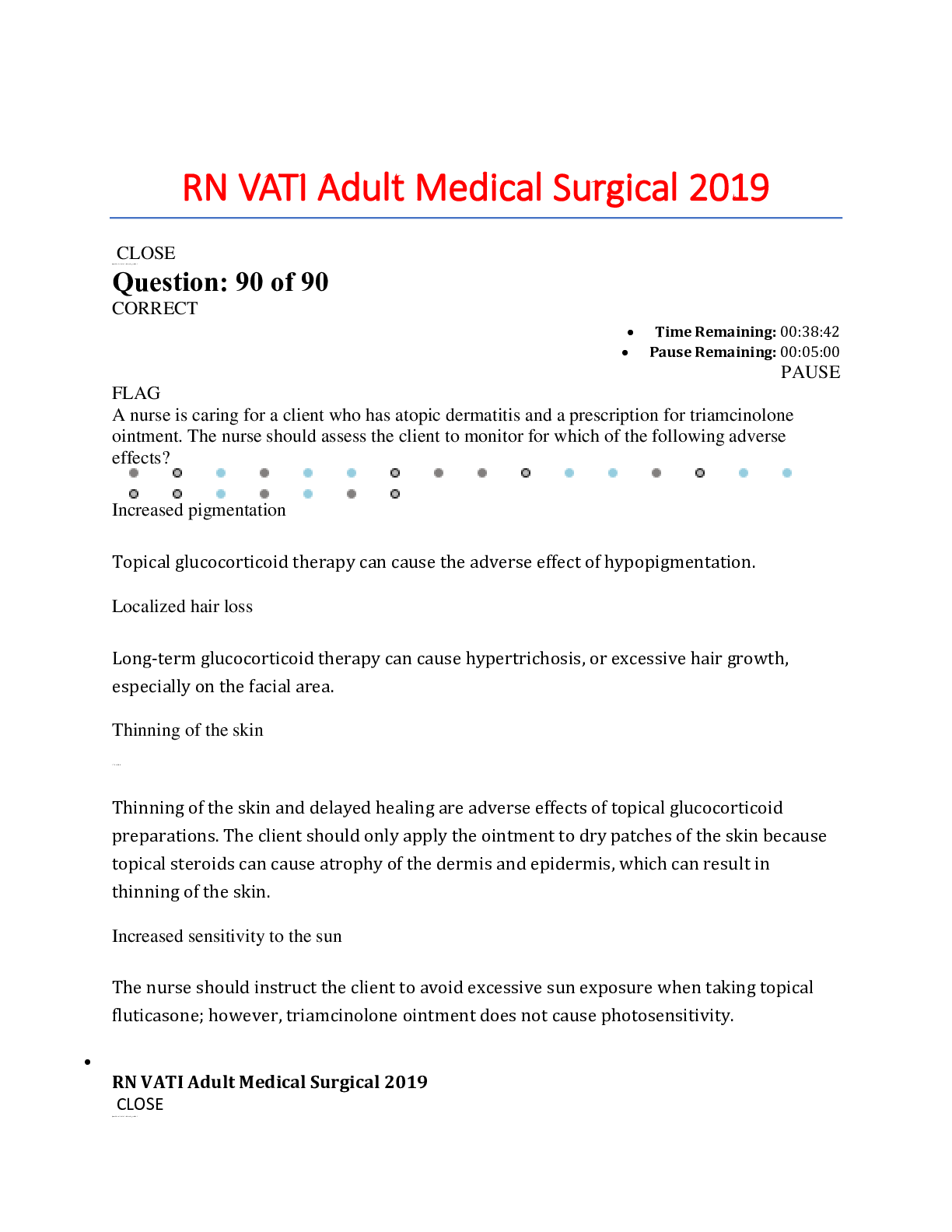
RN VATI Adult Medical Surgical 2019;Mohave Community College - MED SURG 450 RN VATI Adult Medical Surgical 2019
RN VATI Adult Medical Surgical 2019 Question 90 loaded rationals provided Question: 90 of 90 CORRECT FLAG A nurse is caring for a client who has atopic dermatitis and a prescription for triamcinolone...
By Rixx Dennis , Uploaded: Jan 21, 2021
$20
Biology> Judgements > Liberty University - BIO 101 Individual Assignment 2 Answers Liberty University | Complete Solution. (All)
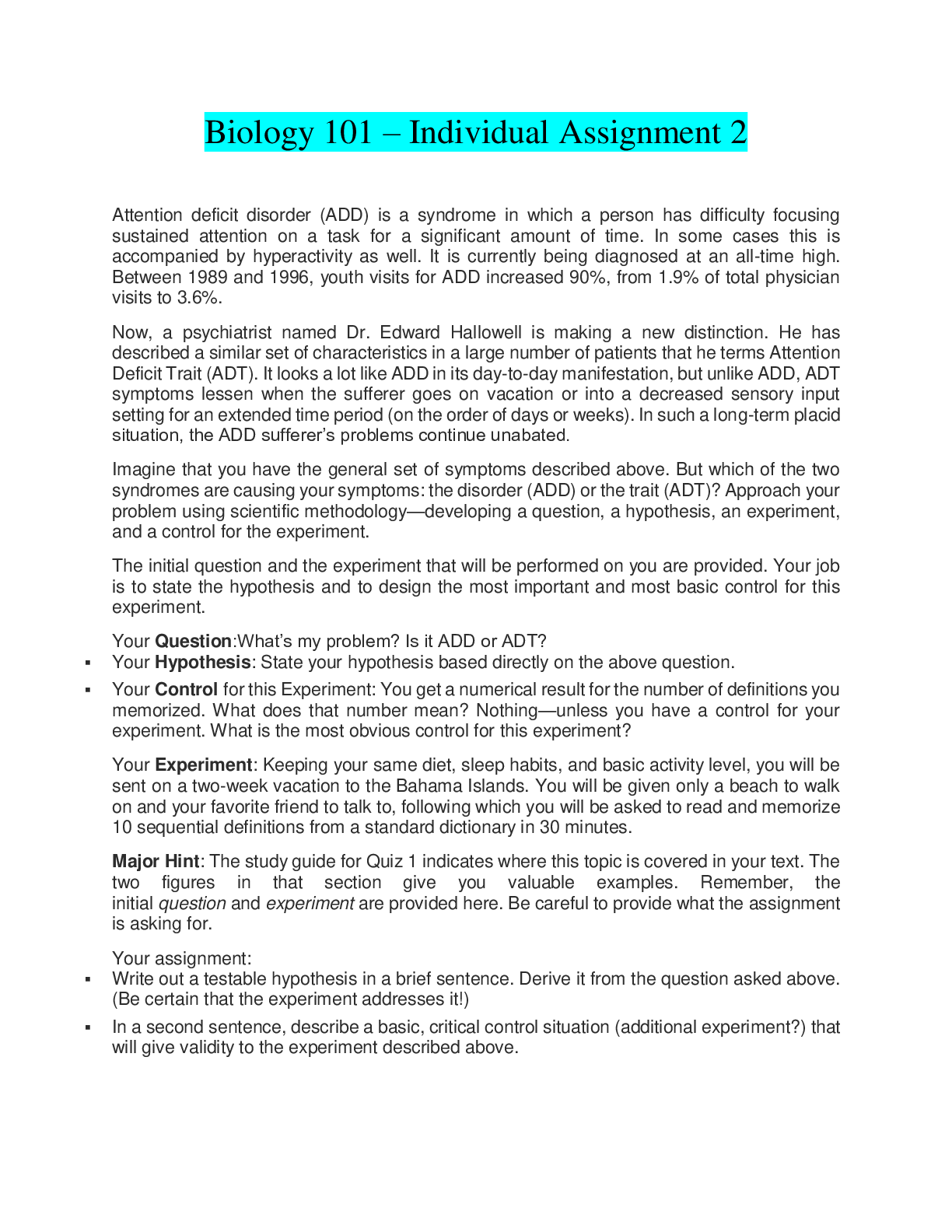
Liberty University - BIO 101 Individual Assignment 2 Answers Liberty University | Complete Solution.
BIOL 101 Individual Assignment 2 Answers Liberty University Attention deficit disorder (ADD) is a syndrome in which a person has difficulty focusing sustained attention on a task for a significant am...
By Expert#1 , Uploaded: Dec 30, 2019
$7
Leadership & Management> Judgements > Grand Canyon University : LDR 600 WEEK 8 DQ 1 And DQ 2 (Newest Solutions) Best Graded Explain Answers. (All)
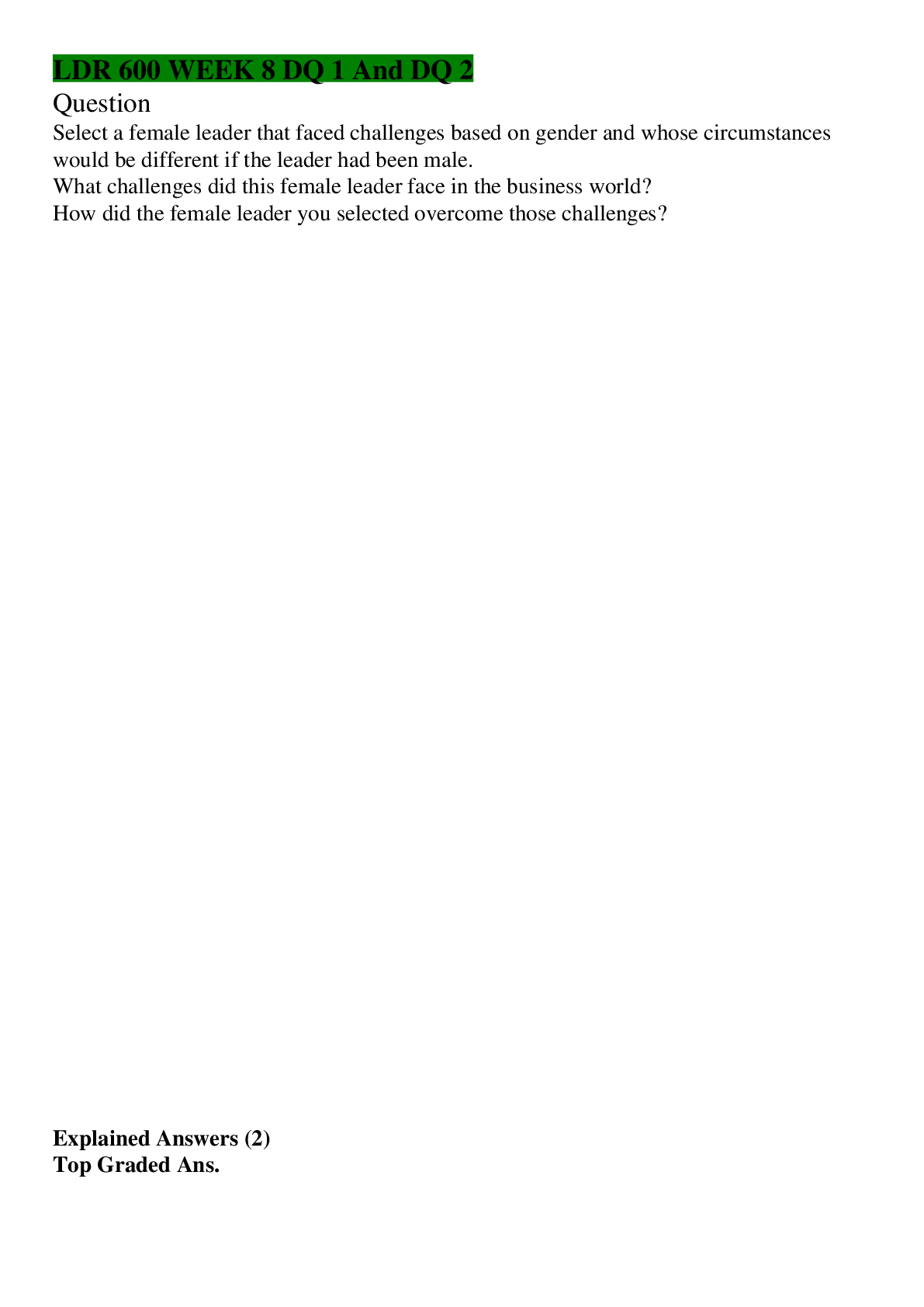
Grand Canyon University : LDR 600 WEEK 8 DQ 1 And DQ 2 (Newest Solutions) Best Graded Explain Answers.
LDR 600 WEEK 8 DQ 1 And DQ 2 Question Select a female leader that faced challenges based on gender and whose circumstances would be different if the leader had been male. What challenges did this...
By Expert#1 , Uploaded: Dec 03, 2019
$5
Education> Judgements > Who killed Barry? Deductive Reasoning Lab with complete solution|Updated (All)
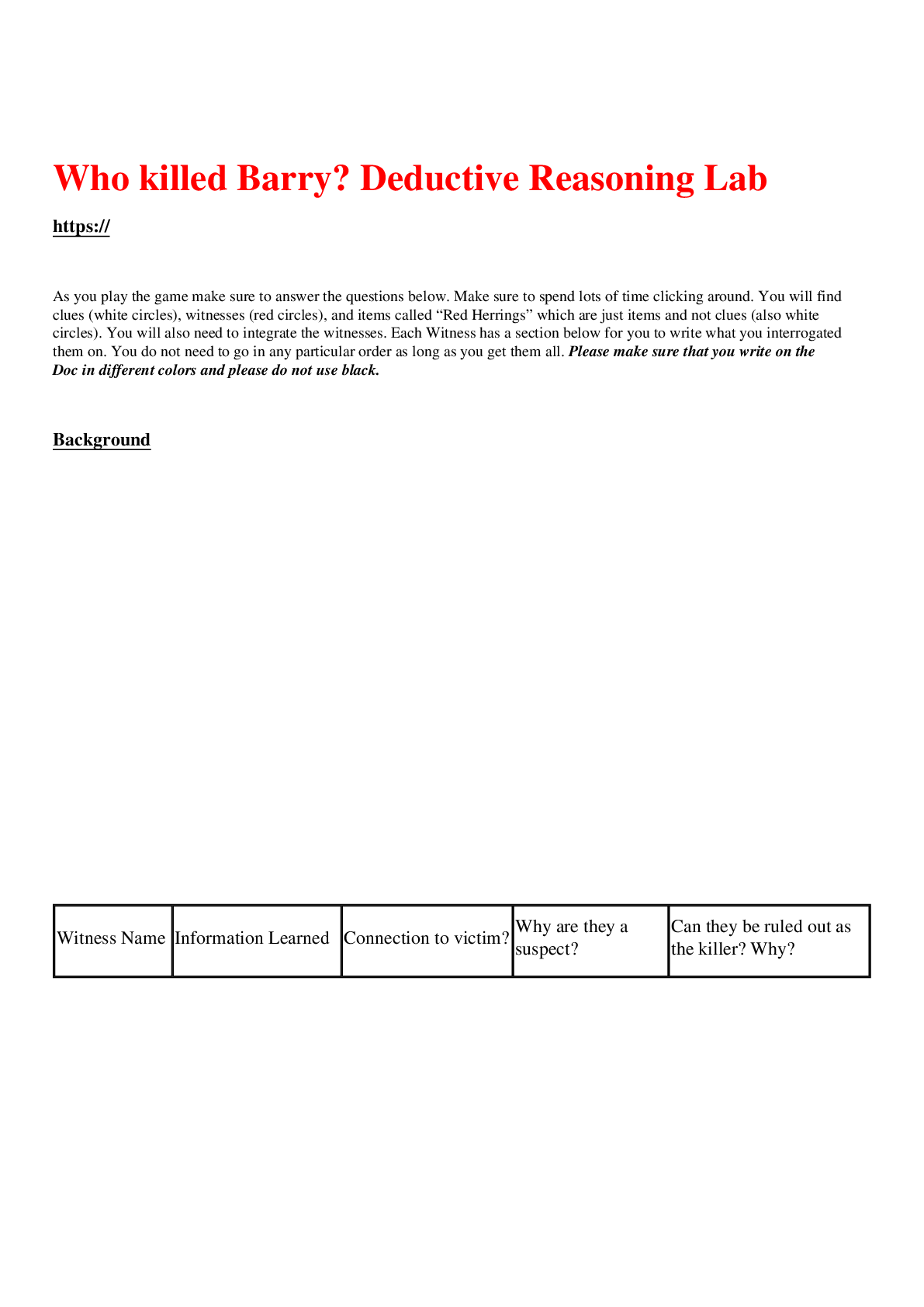
Who killed Barry? Deductive Reasoning Lab with complete solution|Updated
As you play the game make sure to answer the questions below. Make sure to spend lots of time clicking around. You will find clues (white circles), witnesses (red circles), and items called “Red Herri...
By brightstudy , Uploaded: Jan 06, 2023
$7
Psychiatry> Judgements > Nurs 6630 week 7 assignment assessing and treating patients with psychosis and schizophrenia (All)
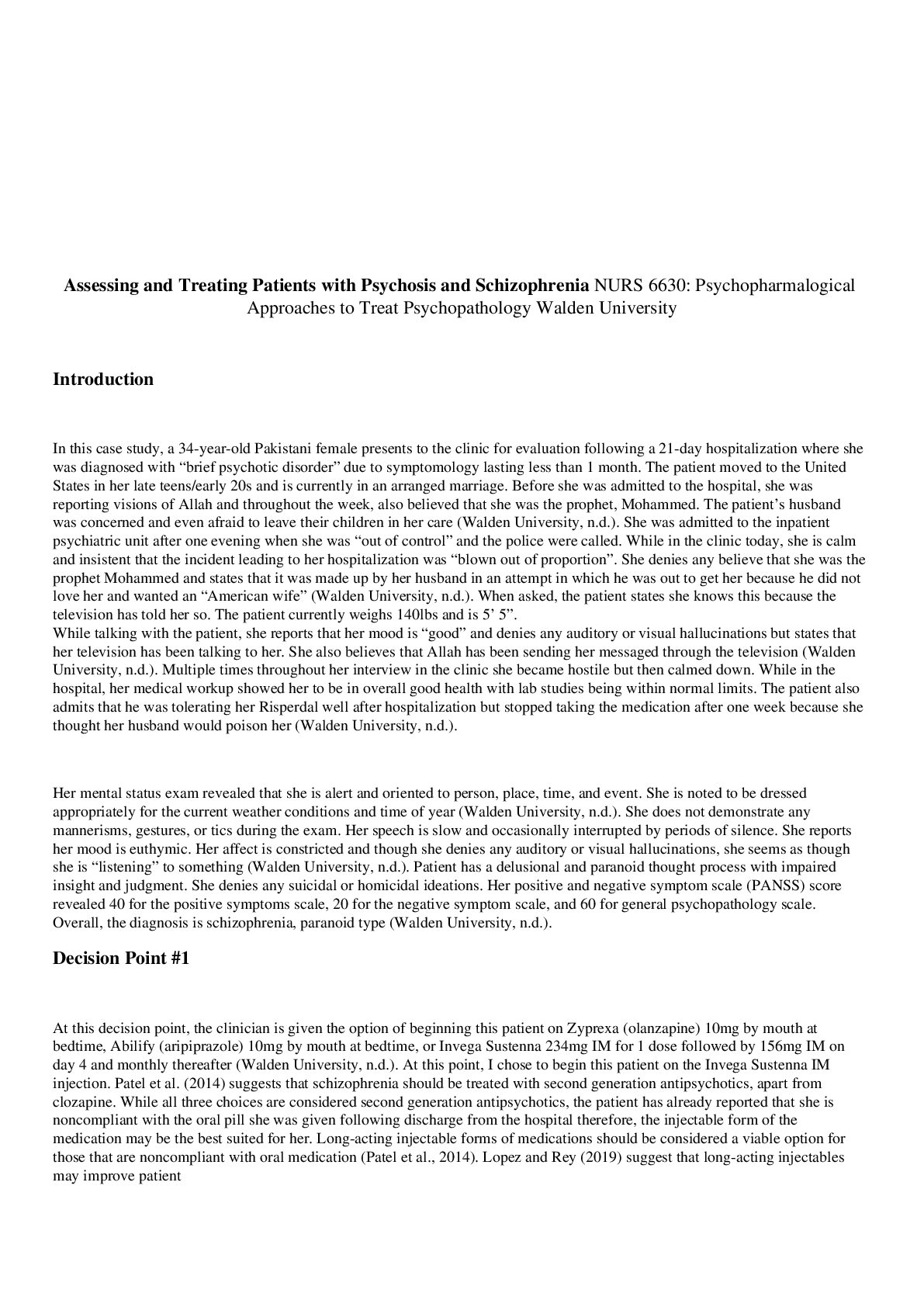
Nurs 6630 week 7 assignment assessing and treating patients with psychosis and schizophrenia
Nurs 6630 week 7 assignment assessing and treating patients with psychosis and schizophrenia
By kian biden , Uploaded: Apr 02, 2023
$10
Document information
Connected school, study & course
About the document
Uploaded On
Dec 16, 2020
Number of pages
20
Written in
Additional information
This document has been written for:
Uploaded
Dec 16, 2020
Downloads
0
Views
101






